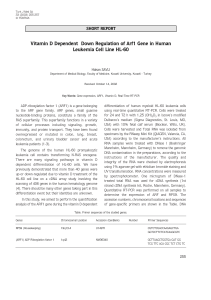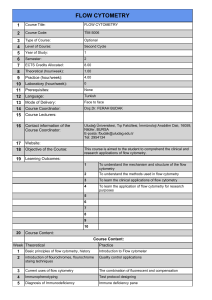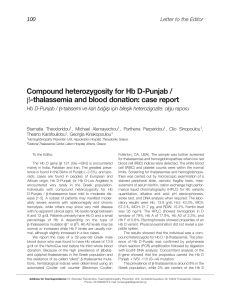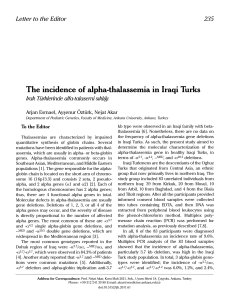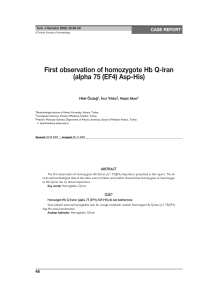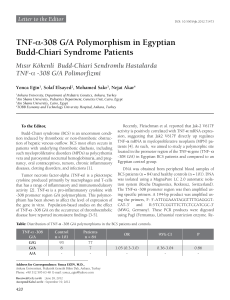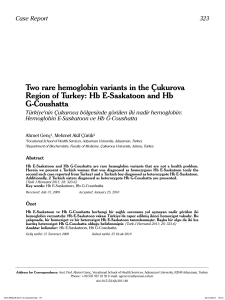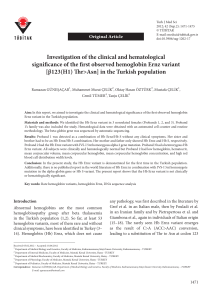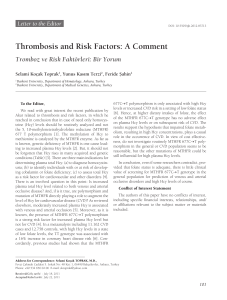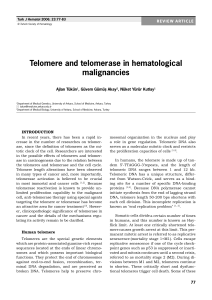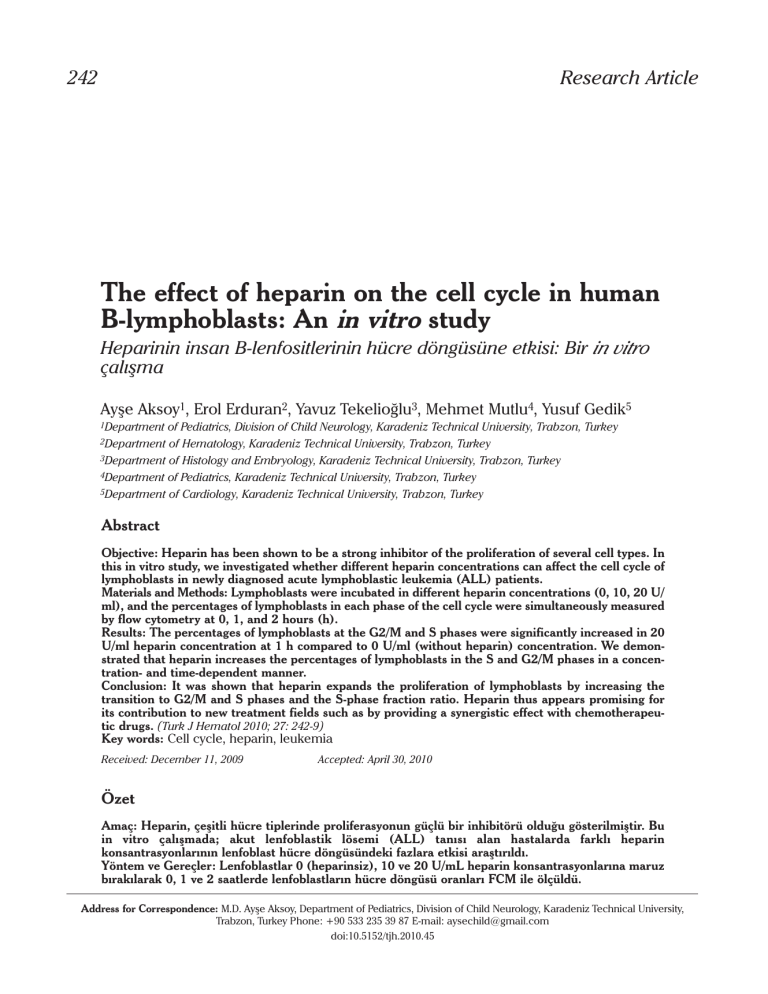
242
Research Article
The effect of heparin on the cell cycle in human
B-lymphoblasts: An in vitro study
Heparinin insan B-lenfositlerinin hücre döngüsüne etkisi: Bir in vitro
çalışma
Ayşe Aksoy1, Erol Erduran2, Yavuz Tekelioğlu3, Mehmet Mutlu4, Yusuf Gedik5
1Department
of Pediatrics, Division of Child Neurology, Karadeniz Technical University, Trabzon, Turkey
of Hematology, Karadeniz Technical University, Trabzon, Turkey
3Department of Histology and Embryology, Karadeniz Technical University, Trabzon, Turkey
4Department of Pediatrics, Karadeniz Technical University, Trabzon, Turkey
5Department of Cardiology, Karadeniz Technical University, Trabzon, Turkey
2Department
Abstract
Objective: Heparin has been shown to be a strong inhibitor of the proliferation of several cell types. In
this in vitro study, we investigated whether different heparin concentrations can affect the cell cycle of
lymphoblasts in newly diagnosed acute lymphoblastic leukemia (ALL) patients.
Materials and Methods: Lymphoblasts were incubated in different heparin concentrations (0, 10, 20 U/
ml), and the percentages of lymphoblasts in each phase of the cell cycle were simultaneously measured
by flow cytometry at 0, 1, and 2 hours (h).
Results: The percentages of lymphoblasts at the G2/M and S phases were significantly increased in 20
U/ml heparin concentration at 1 h compared to 0 U/ml (without heparin) concentration. We demonstrated that heparin increases the percentages of lymphoblasts in the S and G2/M phases in a concentration- and time-dependent manner.
Conclusion: It was shown that heparin expands the proliferation of lymphoblasts by increasing the
transition to G2/M and S phases and the S-phase fraction ratio. Heparin thus appears promising for
its contribution to new treatment fields such as by providing a synergistic effect with chemotherapeutic drugs. (Turk J Hematol 2010; 27: 242-9)
Key words: Cell cycle, heparin, leukemia
Received: December 11, 2009
Accepted: April 30, 2010
Özet
Amaç: Heparin, çeşitli hücre tiplerinde proliferasyonun güçlü bir inhibitörü olduğu gösterilmiştir. Bu
in vitro çalışmada; akut lenfoblastik lösemi (ALL) tanısı alan hastalarda farklı heparin
konsantrasyonlarının lenfoblast hücre döngüsündeki fazlara etkisi araştırıldı.
Yöntem ve Gereçler: Lenfoblastlar 0 (heparinsiz), 10 ve 20 U/mL heparin konsantrasyonlarına maruz
bırakılarak 0, 1 ve 2 saatlerde lenfoblastların hücre döngüsü oranları FCM ile ölçüldü.
Address for Correspondence: M.D. Ayşe Aksoy, Department of Pediatrics, Division of Child Neurology, Karadeniz Technical University,
Trabzon, Turkey Phone: +90 533 235 39 87 E-mail: [email protected]
doi:10.5152/tjh.2010.45
Aksoy et al.
Heparin and human B-lymphoblast cell cycle
Turk J Hematol 2010; 27: 242-9
243
Bulgular: Lenfoblastlar, 0 U/mL heparinsiz konsantrasyonuna göre; 20 U/mL heparin konsantrasyonunun 1. saatinde en fazla olmak üzere G2/M ve S döngüsü anlamlı derecede artmıştır. Heparinin
doza ve zamana bağlı olarak lenfoblastların G2/M ve S fazlarında artışa neden olduğunu gösterdik.
Sonuç: Heparin, hücre döngüsünde G2/M ve S fazına geçişi artırarak lenfoblastlarda proliferasyonu
artırdığı gösterildi. Böylece heparinin, kemoterapi ilaçları ile sinerjistik etki sağlayarak yeni tedavi
alanlarına olası katkıları umut verici olarak görünüyor. Bu ön çalışmamızın sonuçları, heparinin lenfoblastlardaki proliferatif etkisini araştırmak amacı ile daha ayrıntılı ve kapsamlı çalışma yapılması
gerektiği gösterir. (Turk J Hematol 2010; 27: 242-9)
Anahtar kelimeler: Hücre siklusu, heparin, lösemi
Geliş tarihi: 11 Aralık 2009
Kabul tarihi: 30 Nisan 2010
Introduction
Heparin, which is generally used as an anticoagulant but has been shown to have additional biological
activities, was determined in several clinical trials to
have an effect on malignancies. The activities of
heparin include anticoagulant, tissue factor pathways inhibitor release, heparinase inhibition, selectin-mediated interaction inhibition, modulation of the
activity of some proteases and extracellular matrix
components, and growth factor binding [1-6].
Leukemia cells were found sensitive to chemotherapeutic agents that either interfere with the cell
cycle or cause apoptosis [7-9]. Some anti-cancer
reagents cause cell death through interfering with
the processes of the cell cycle, while others cause
cell death by apoptosis, which plays an important
role in the balance between cell replication and cell
death [7,10]. Almost all conventional anticancer
drugs are primarily effective against rapidly dividing
cells [11]. Compared with proliferating lymphocytes, a 500-fold higher concentration of chemotherapeutic drug is required to kill resting cells [12].
In initial acute lymphoblastic leukemia (ALL), a
higher fraction of proliferating cells seems to result
in a higher efficacy of the chemotherapeutic drug
targeting the cell division cycle. Interestingly, at first
presentation of childhood ALL, the prognostic value
of the proliferative capability of lymphoblasts
remains controversial, and there is no clear evidence of an association with prognosis [13-15].
However, in in vitro experiments, an increased proliferation rate was associated with good response to
treatment [15].
The S-phase fraction (SPF) measures the percentage of a given cycling subpopulation between
G0/G1 and G2/M phases, and it reflects cell proliferation [16]. The SPF has been studied in different
malignancies including ALL for the purpose of classification or prognosis. It has been proven to be a
useful prognostic marker in types of solid cancers
and leukemia [14,17-19]. However, contradictory
results have been reported concerning the prognostic value of the SPF of leukemia cells [13-15].
To date, no study dealing with the proliferative
activity of heparin in human lymphoblasts has been
undertaken. In this in vitro study, we investigated
whether heparin can affect proliferation of lymphoblasts in newly diagnosed ALL patients. We also
attempted to establish by flow cytometry (FCM)
which phase in the cell cycle of the lymphoblasts
can be considered heparin-sensitive. This was
determined by analyzing the correlation between
the SPFs and the effect of heparin on the lymphoblast cell cycle.
Materials and Methods
Twelve children (8 girls, 4 boys; age: 2-15 years)
with newly diagnosed ALL (all had B-cell leukemia)
were included in the study with the written consent
of their parents. The clinical features of the 12
patients are shown in Table 1. Diagnosis of the
patients was done according to the findings of complete blood counts, peripheral and bone marrow
aspiration (BMA) smears, histochemical staining of
BMA smears, and FCM analysis (Coulter Epics Elite
ESP Flow Cytometry) of BMA materials. ALL was
diagnosed by examining a lymphoblast population
of more than 25% in the BMA smears. No patients
had Philadelphia chromosome.
Cell typing
CD3 PE (Coulter PN IM1282), CD7 FITC (Coulter
PN IM0585), CD10 FITC (Coulter PN IM0471), CD13
FITC (Coulter PN IM0778), CD14 FITC (Coulter PN
IM0650), CD19 FITC (Coulter PN IM1284), CD20 FITC
(Coulter PN IM1455), CD33 FITC (Coulter PN
IM1179), CD45 FITC (Coulter PN IM0782) and MPO
FITC (Coulter PN IM1874) monoclonal antibodies
244
Aksoy et al.
Heparin and human B-lymphoblast cell cycle
Turk J Hematol 2010; 27: 242-9
Table 1. Clinical features of children with acute lymphoblastic leukemia
Patient no
Sex
Age (yr)
Stage of disease
WBC
(x 103/μl)
% Blast
(BM)
Immunophenotype
1
F
4
Diagnosis
1.2
98
CD10, CD19, CD20
2
F
3
Diagnosis
120.0
88
CD10, CD19, CD20
3
F
3
Diagnosis
25.2
96
CD10, CD19
4
M
5
Diagnosis
2.8
95
CD10, CD19
5
F
2
Diagnosis
7.8
88
CD10, CD19
6
M
7
Diagnosis
44.7
89
CD10
7
F
4
Diagnosis
30.3
95
CD10, CD20
8
M
14
Diagnosis
2.7
97
CD10
9
F
15
Diagnosis
127.0
90
CD19, CD20
10
F
2
Diagnosis
13.1
90
CD10
11
M
6
Diagnosis
99.2
88
CD10
12
F
5
Diagnosis
9.7
98
CD19, CD20
WBC: Leukocyte counts at diagnosis; BM: Bone marrow
were used for the diagnosis of ALL. All patients had
monoclonal antibody positivity for B-cell leukemia.
Separation of Blast Cells
Bone marrow aspiration (BMA) materials were
drawn into a tube with ethylene diamine tetraacetate (EDTA). The same quantities of phosphatebuffered saline (PBS) and the BMA sample were
added into the tube. The sample was stirred, and
waited for 30 minutes (min) at room temperature.
Buffy coat obtained from the upper surface of the
specimen was added onto Ficoll-Hypaque 1077
(lymphocyte separation medium Gibco BRL 1301012, Grand Island, NY) and centrifuged at 700 g for 30
min. Mononuclear cells containing ≥90% lymphoblasts were obtained from the upper surface of the
specimen and washed twice with PBS to exclude
debris. The blast cells were suspended at a concentration of 3-5 x105 cells/ml in RPMI with L-glutamine
without sodium bicarbonate medium (Sigma
R-6504, Miami, FL). 100 ml of each material was
studied for immunotyping by FCM. The remaining
amount of each sample was kept at -80°C approximately five-seven months until the study was performed. Viability of lymphoblasts was again determined after having the samples using acridine
orange. Lymphoblasts with viability higher than 70%
were used in the study.
Pure heparin was used in the study (Sigma
Biochemicals and Reagents-2001 Catalog, Sigma H
3149). The purity and activity of heparin were Grade
I, ≥140 USP unit/mg. The heparin did not include
the additional stabilizing agents. The blast cell suspensions were thawed at room temperature. No
heparin (0 U/ml) or different heparin concentrations (10, 20 U/ml) were added on the blast cells
(1 ml). Each tube included different heparin concentrations and was divided into three different
tubes. All the samples were processed with a
Coulter DNA-prep reagent kit (CN: 640445) at 0, 1,
and 2 hours (h). The DNA-prep reagent kit contained DNA prep-LPR solution (<0.1% potassium
cyanide, <0.1 sodium nitride, nonionic detergents,
saline, and stabilizers) and the DNA-prep stain
(50 μg/ml propidium iodide [PI], <0.5% NaN3,
saline, and stabilizers). The blast membranes were
pored by the DNA-prep LPR solution, and RNAs and
DNAs of the blasts were stained with PI. Stained
RNAs were removed from the medium by RNAse;
therefore, DNA content was marked by PI. The aliquots were taken following 0, 1, and 2 h, and FCM
analyses were carried out for cell cycle of the blast
cells in a Coulter Epics Elite Flow Cytometer
(Multicycle DNA, Phoenix Flow Systems, San Diego,
CA). The FCM analyses were immediately done
within 3-5 seconds after adding no heparin or different heparin concentrations (0, 10 and 20 U/ml) on
to the blasts.
Flow cytometric (FCM) analyses could not be
performed in 10 and 20 U/ml heparin concentrations at 3h because the samples were seen to have
transformed into a gelatinous substance. A gelatinous substance similarly developed following the
addition of higher heparin concentrations (30 and
50 U/ml) into the lymphoblast samples.
Aksoy et al.
Heparin and human B-lymphoblast cell cycle
Turk J Hematol 2010; 27: 242-9
The percentages of the cells in the G0/G1, G2/M
and S phases were determined from an analysis
using the PEAK computer program, generously provided by Dr. Phillip Dean [20]. Since only samples
that contained more than 80% leukemic cells were
included, the lymphoblast proliferative activity was
expressed in terms of the calculated percentage of
cells in the S phase of their cycle.
The fraction of cells in the G0/G1, S and G2/M
phases of the cell cycle is mathematically determined from the DNA distribution. The SPF is the
fraction of the total cell population in the S phase of
the cell cycle [16].
S
X 100
SPF=
G0/G1+S+G2/M
Statistical Analysis
Data obtained from FCM and fluorometrik measurements were analyzed by the SPSS version 10.0
statistical package program. Variance analysis was
used in the repeated measurements and the comparison of groups. The normal distribution of the
data was assessed by Kolmogorov-Smirnov test.
Paired t test (post hoc) was used to determine the
statistically significant differences between measurements using different heparin concentrations.
Results were calculated as arithmetic mean ±standard deviation (x±SD).
cells in the G0/G1 phase in 20 U/ml heparin concentration at 1 h was significantly lower than in 0 U/ml
(without heparin) and 10 U/ml heparin concentrations at 1 h (p<0.001), and in 20 U/ml heparin concentration at 0 h (p<0.001). There were significant
differences between the percentage of the lymphoblasts in 20 U/ml and 10 U/ml heparin concentrations and 0 U/ml (without heparin) at 2 h (p<0.001).
The mean percentage of blast cells in the G2/M
phase in the different heparin concentrations at 0, 1,
and 2 h are shown in Table 3. There were significant
differences in the mean percentage of blast cells in
the G2/M phase in 0 U/ml (without heparin) concentration at 0, 1, and 2 h (p<0.001). The lowest percentage of blast cells in the G2/M phase was determined
in 0 U/ml without heparin concentration at 2 h. The
highest percentage of blast cells in the G2/M phase
was determined in 20 U/ml heparin level at 1 h. The
mean percentage of blast cells in the G2/M phase in
20 U/ml heparin concentration at 1 h was significantly higher than those in 0 U/ml and 10 U/ml heparin concentrations at 1 h (p<0.001), and in 20 U/ml
heparin concentration at 0 h (p<0.003). The mean
percentage of blast cells in 20 U/ml heparin level at 1
Table 2. Percentages of lymphoblasts in the G0/G1 phase in 0 U/ml
(without heparin), 10 and 20 U/ml heparin concentrations at 0, 1,
and 2 hours (%, mean±SD, min.-max.)
Heparin
0 U/ml
Results
10 U/ml
The cell cycle analyses were performed without
heparin and with heparin at varying concentrations
(0, 10 and 20 U/ml) at 0, 1, and 2h after adding
heparin on to the lymphoblasts. However, the samples with heparin were seen to transform into a
gelatinous substance after 2 h; hence, FCM analysis
could not be performed.
The mean percentage of blast cells in the G0/G1
phase in different heparin concentrations at 0 (without heparin), 1, and 2 h are shown in Table 2. In 0 U/
ml (without heparin) concentration, the mean percentage of blast cells in the G0/G1 phase at 2 h was
significantly lower than those at 0 h and 1 h
(p<0.001). The highest percentage of blast cells in
the G0/G1 phase was established in 0 U/ml (without
heparin) at 0 h. The lowest percentage of blast cells
in the G0/G1 phase was determined in 20 U/ml
heparin level at 1 h. The mean percentage of blast
245
20 U/ml
0
Time (hour)
1
2
97.80±0.51a
97.72±0.47 d
97.62±0.48 g
97.0 - 98.5
97.0 - 98.3
96.9 - 98.2
85.38±4.3 b
85.54±2.06 e
90.77±0.81 h
78.9 - 92.0
82.4 - 89.0
90.0 - 92.0
88.38±3.12 c
76.91±4.58 f
78.34±2.12 i
83.3 - 92.0
69.6 - 84.5
74.9 - 81.0
a-b, a-c, c-f, c-i, d-e, d-f, e-h, e-f, g-h, g-i, h-i: p<0.001, b-h: p<0.001
Table 3. Percentages of lymphoblasts in the G2/M phase in 0 U/ml
(without heparin), 10 and 20 U/ml heparin concentrations at 0, 1,
and 2 hours (%, mean±SD, min.-max.)
Heparin
0
Time (hour)
1
2
0 U/ml
1.16±0.42 a
1.18±0.42 d
1.08±0.43 g
0.5 - 1.9
0.5 - 1.9
0.4 - 1.8
10 U/ml
7.24±1.9 b
4.50±1.74 e
3.00±0.76 h
4.1 - 10.1
1.8 - 7.4
1.3 - 4.0
6.00±1.95 c
10.21±3.49 f
9.37±2.65 i
3.0 - 9.0
5.4 - 18.4
4.9 - 13.0
20 U/ml
a-b, a-c, b-e, b-h, d-f, e-f, g-i, h-i: p< 0.001, c-f: p<0.003, d-e: p<0.003,
c-i, e-h: p<0.006, g-h: p<0.0
246
Aksoy et al.
Heparin and human B-lymphoblast cell cycle
Turk J Hematol 2010; 27: 242-9
h was significantly higher than those in 0 U/ml (without heparin) and 10 U/ml heparin levels (p<0.001).
The mean percentage of blast cells in the S
phase in different heparin concentrations at 0, 1,
and 2 h are shown in Table 4. The mean percentage
of blast cells in the S phase in 0 U/ml (without heparin) concentration was the same at 0, 1, and 2 h.
The lowest percentage of blast cells in the S phase
was determined in 0 U/ml (without heparin) concentration. The highest percentage of blast cells in
the S phase was determined in 20 U/ml heparin
concentration at 1 h. The mean percentage of the
blast cells in the S phase in 20 U/ml heparin concentration at 1 h was significantly higher than in 0 U/ml
(without heparin) and 10 U/ml heparin concentrations (p<0.001, p<0.006, respectively) and in 20 U/
ml heparin concentration at 0 h (p<0.001). There
were significant differences between the percentages of the blast cells in 20 U/ml and 10 U/ml, and
20 U/ml and 0 U/ml heparin levels in S phase at 1 h
(p<0.001), and the highest percentage of the lymphoblasts in S phase at 2 h was detected in 20 U/ml
heparin level.
In the 0 U/ml (without heparin) concentration at
0 h, 97.80% of the lymphoblasts were in the G0/G1
phase, and this value dropped to 76.91% in 20 U/ml
heparin concentration at 1 h (p<0.001). Similarly,
at 0 h, 1.16% of the lymphoblasts were in G2/M
phase, and this value increased to 10.21% in 20 U/
ml heparin concentration at 1 h (p<0.001). Also at
0 h, 1.03% of the lymphoblasts were in S phase,
and this value increased to 13.63% in 20 U/ml
heparin concentration at 1 h (p<0.001). G0/G1
phase cell population decreased while G2/M and S
phase cells increased in 10 U/ml and 20 U/ml concentrations at 1 and 2 h compared to cell populations at 0 h (p<0.001).
Table 4. Percentages of lymphoblasts in the S phase in 0 U/ml
(without heparin), 10 and 20 U/ml heparin concentrations at 0, 1,
and 2 hours (%, mean±SD)
Heparin
0 U/ml
10 U/ml
20 U/ml
0
Time (hour)
1
2
1.03±0.60 a
1.03±0.60 d
1.03±0.60 g
0.2 - 2.0
0.2 - 2.0
0.2 - 2.0
7.43±3.61b
10.12±2.71e
6.22±0.95 h
3.0 - 14.4
7.0 - 15.3
5.0 - 7.9
5.45±2.31c
13.63±3.47 f
12.11±2.73 i
2.2 - 7.5
10.0 - 21.4
9.9 - 17.4
a-b, a-c, c-f, c-i, d-e, e-h, d-f, g-h, g-i, h-i: p<0.001, e-f: p<0.006
The SPF was determined in the 0 U/ml (without
heparin), 10 U/ml and 20 U/ml heparin concentrations at 0, 1 and 2 h, with values ranging from
1-13.6% (data not shown). While the SPF values in
the 0 U/ml (without heparin) at 0 h, 1 h and 2 h were
1%, the highest SPF value was 13.6% in the 20 U/ml
heparin concentration at 1 h. We found a statistically significant difference in the mean SPF ratio in
the 20 U/ml heparin concentration at 1 h compared
to the other groups (p<0.05).
Prominent alterations in the cell cycle distribution were observed in 20 U/ml heparin concentration at 1 h. There was a movement of lymphoblast
cells from G0/G1 to G2/M and S phases. The percentage of lymphoblasts in the G0/G1 phase was
decreased while the percentage of lymphoblasts in
the G2/M and S phases was increased in 20 U/ml
heparin level at 1 h. This study showed that the
effect of heparin in the cell cycle of lymphoblasts
was associated with a decrease in the percentage
of G0/G1 phase cells and an increase in the percentage of G2/M and S phase cells in a dose- and time–
dependent manner. In other words, we found that
heparin increases both the percentage of lymphoblast cells in G2/M and S phases and the SPF ratio in
20 U/ml heparin level at 1 h. The FCM histograms of
lymphoblasts depicted characteristic DNA distributions in 0 U/ml (without heparin) and 20 U/ml heparin concentrations at 1 h in a patient (no: 6) with
ALL [Figure 1(A) and (B)]. Comparisons of the percentages of the lymphoblastic cell populations in 0
U/ml (without heparin) and 20 U/ml heparin levels
in the G0/G1, S and G2/M cell cycle phases at 1 h are
shown in Figure 1(A) and 1(B), respectively.
Discussion
In the present study, we have demonstrated that
heparin increases the percentages of lymphoblasts
in the S and G2/M phases and the SPF ratio in a concentration- and time-dependent manner. This indicates that heparin may induce the proliferation of
lymphoblasts by increasing the cell cycle percentages in the G2/M and S phases and the SPF ratio. To
the best of our knowledge, no study has reported on
the influence of heparin on the cell cycle of lymphoblasts and the correlation with the SPF.
Although previous works demonstrated that heparin could inhibit proliferation of hepatoma cells,
vascular smooth muscle cells, renal mesangial
cells, and cervical epithelial cells, we have shown
that heparin induced lymphoblast proliferation by
Aksoy et al.
Heparin and human B-lymphoblast cell cycle
Turk J Hematol 2010; 27: 242-9
1000
HI009514.HST HISTO
PMT4
CELL CYCLE
SO
800
PE009632.HST ped
1000
DATA
Mean G1=54.8
SL CL SO
Cell Number
Cell Number
%G1 =98.3
Mean G2 108.5
CV G2 =3.2
%G2 =1.2
400
% S = 0.6
200
CELL CYCLE
DATA
Mean G1=54.4
CV G1 =3.4
%G1 =71.9
800
CV G1 =4.9
600
247
600
Mean G2 113.1
CV G2 =2.7
%G2 =18.2
400
% S = 9.9
G2/G1 = 2.077
200
G2/G1 = 1.980
0
0
A
32
64
96
128
160
DNA Content
192
224 256
0
0
Chi Sp.=1.3
B
Chi Sp. = .9
32
64
36 128 160 192 224 256 % Agg. = .1
DNA Content
Chi Sp. = 3.0
Figure 1(A) and (B). Comparison of the percentage of the lymphoblastic cell populations in 0 U/ml (without heparin) (A) and 20 U/ml (B)
heparin levels in the G0/G1, S and G2/M cell cycle phases at 1 hour (respectively, left and right) (No: 6)
increasing the cell cycle percentages in the S and
G2/M phases [1,21-24]. The antiproliferative activity
of heparin has been linked to the blockage of the G1
phase of the cell cycle, and also reduces the number of cells entering the cycle from G1 [1,3,22,25,26].
Even though it is known from earlier studies that
heparin has an antiproliferative effect on non-cancerous cells, it is quite interesting that it was shown
in this study to increase proliferation in lymphoblasts. The mechanism responsible for these effects
of heparin must be investigated in further studies.
On the other hand, heparin causes apoptosis in
human peripheral blood neutrophils, lymphoblasts
and mononuclear cells, and indicates its apoptotic
effect on lymphoblasts via extrinsic or intrinsic pathways [27-29].
We demonstrated in this study that the greatest
proliferation effect of heparin and the highest SPF
ratio were determined in 20 U/ml concentration at 1
h. Recent studies from Erduran et al. [30] determined that the greatest apoptotic effect of heparin
on the lymphoblasts was detected in 20 U/ml concentration at 1 h. The results of some recent studies
were found to be concordant [28-30]. Apoptosis
and proliferation are important regulators of normal
development and homeostasis in the bone marrow.
According to the knowledge gained in previous
experimental studies, a greater regenerative capacity of hematopoiesis may be reflected by an
increased rate of apoptosis and/or proliferation and
therefore is associated with a more favorable outcome [31]. According to these results, we suggest
that heparin may have a dual effect on lympho-
blasts by stimulating apoptosis in a portion of them,
while increasing proliferation in others by stimulating S and G2/M phases in the cell cycle. Whether or
not this dual effect contributes to prognosis will
require further investigation. We did not aim to
show which molecular pathway is involved in the
proliferative effect of heparin on the lymphoblast
cell cycle. In view of the preliminary nature of our
study, our purpose was only to establish whether or
not heparin had any effect on the cell cycle of lymphoblasts. We believe that the relationship among
heparin, cell cycle phases and apoptosis needs to
be studied at the molecular level.
Chemotherapy agents may work in only one
phase of the cycle (termed “cell-cycle specific”)
(e.g. azathioprine, cytosine arabinoside (Ara-C),
hydroxyurea, and vincristine), or in all phases (‘cellcycle nonspecific”). Many chemotherapeutic drugs
are effective on the cells in the S phase of the cell
cycle [8-11,32]. Bone marrow samples generally
had a higher SPF ratio than blood samples in children with leukemia [33]. The relationship of leukemic blast proliferative activity to prognosis is controversial. Duque et al. [14] reported that the SPF was
not prognostic for treatment response or response
duration in acute leukemia in general. On the other
hand, several studies reported that bone marrow
SPFs of >6% were strongly predictive of outcome in
childhood ALL [33,34]. In contrast, Braess et al. [13]
found that a high proliferative activity was associated with a higher complete remission rate in 187
patients with acute myeloblastic leukemia. On the
other hand, it has been demonstrated that stimula-
248
Aksoy et al.
Heparin and human B-lymphoblast cell cycle
tion of cell proliferation of leukemia cells by pretreatment with growth factors (granulocyte colonystimulating factor, granulocyte-macrophage colonystimulating factor, interleukin-3) in combination
with cycle-specific cytotoxic drugs as chemosensitizing agents could enhance in vitro sensitivity to
some chemotherapeutic agents for killing of leukemic stem cells [35-38]. It was reported that an
increased in vitro sensitivity to several chemotherapeutic drugs, such as vincristine and L-asparaginase,
was related to higher SPF of lymphoblasts isolated
from initial childhood ALL patients. Especially the
SPF of pretreatment childhood ALL samples
appeared to correlate with the in vitro sensitivity to
several chemotherapeutic drugs [15]. Since
increased proliferative activity may increase the
sensitivity to chemotherapeutic drugs, pretreatment
with growth factors prior to treatment with these
proliferation-dependent drugs may increase the
response rate in childhood acute leukemia. The
increased proliferative effect of heparin on lymphoblasts will be important for its contribution to new
treatment fields. Our results presented here indicate that heparin increases the proliferation of lymphoblasts in G2/M and S phases and the SPF.
Heparin might increase the effect of chemotherapeutic drugs on lymphoblasts that are in the G2/M
and S phases. Alternatively, heparin combined with
chemotherapeutic agents might be a feasible
approach to increase the effectiveness of the chemotherapy with relative specificity for the lymphoblasts, but these results should be tested in vivo. We
lack data for comparison of the effect of heparin on
various types and stages of leukemia.
Thromboembolism is a common finding in
patients with malignancy and a well-recognized
serious complication during chemotherapy, such as
with Ara-C. Anticoagulation with heparin has also
been suggested in children undergoing some kinds
of ALL therapy [39]. Our results might suggest that
pretreatment with heparin as a chemosensitizing
approach could be useful for patients with ALL who
are prone to thrombosis. The proliferative and
apoptotic effects of heparin on lymphoblasts might
present new opportunities in the treatment of childhood ALL. This study provides pilot data for a future
randomized trial of the use of heparin during ALL
therapy for the prevention of some chemotherapeutic agent-associated thrombotic events.
In conclusion, in addition to its anticoagulant
effect, heparin might be useful in children with ALL
Turk J Hematol 2010; 27: 242-9
because it induces the transition of the lymphoblasts from the G0/G1 phase to G2/M and S phases.
In addition, heparin might increase the effect of
chemotherapeutic drugs on lymphoblasts that are
in the G2/M and S phases. There are no reports
related to the enhancement of chemotherapeutic
drug sensitivity by heparin in the treatment of ALL or
any type of leukemia. The findings of this preliminary study indicate that further and more comprehensive research on the effects of heparin on the
lymphoblast cell cycle is needed to explore the
therapeutic potential of heparin in patients with ALL
or any kind of leukemia.
Conflict of interest
No author of this paper has a conflict of interest,
including specific financial interests, relationships,
and/or affiliations relevant to the subject matter or
materials included in this manuscript.
References
1.
2.
3.
4.
5.
6.
7.
8.
9.
10.
11.
Zacharski LR, Ornstein DL, Mamourian AC. Lowmolecular-weight heparin and cancer. Semin Thromb
Hemost 2000;26:69-77.
Nelson RM, Cecconi O, Roberts WG, Aruffo A, Linhardt
RJ, Bevilacqua MP. Heparin oligosaccharides bind Land P-selectin and inhibit acute inflammation. Blood
1993;82:3253-8.
Mandal AK, Lyden TW, Saklayen MG. Heparin lowers
blood pressure: biological and clinical perspectives.
Kidney Int 1995;47:1017-22.
Lever R, Page CP. Novel drug development opportunities for heparin. Nat Rev Drug Discov 2002;2:140-8.
Borsing L. Antimetastatic activities of modified heparins: selectin inhibition by heparin attenuates metastasis. Semin Thromb Hemost 2007;33:540-6.
Smorenburg SM, Van Noorden CJ. The complex effects
of heparins on cancer progression and metastasis in
experimental studies. Pharmacol Rev 2001;53:93-105.
Feng Y, Wu J, Feng X, Tao D, Hu J, Qin J, Li X, Xiao W,
Gardner K, Judge SI, Li QQ, Gong J. Timing of apoptosis onset depends on cell cycle progression in peripheral blood lymphocytes and lymphocytic leukemia
cells. Oncol Rep 2007;17:1437-44.
Eastman A. Cell cycle checkpoints and their impact on
anticancer therapeutic strategies. J Cell Biochem
2004;91:223-31.
Schmidt M, Bastians H. Mitotic drug target and the
development of novel anti-mitotic anticancer drugs.
Drug Resist Updat 2007;10:162-81.
Dirsch VM, Antsperger DS, Hentze H, Vollmar AM.
Ajoene, an experimental anti-leukemic drug: mechanism of cell death. Leukemia 2002;16:74-83.
Banker DE, Groudine M, Willman CL, Norwood T,
Appelbaum FR. Cell cycle perturbation in acute myeloid
Aksoy et al.
Heparin and human B-lymphoblast cell cycle
Turk J Hematol 2010; 27: 242-9
12.
13.
14.
15.
16.
17.
18.
19.
20.
21.
22.
23.
24.
25.
26.
leukaemia samples following in vitro exposures to
therapeutic agents. Leukaemia Res 1998;22:221-39.
Carson DA, Wasson DB, Teatle R, Yu A. Specific toxicity
of 2- holoradeoxyadenosine toward resting and proliferating human lymphocytes. Blood 1983;62:737-43.
Braess J, Jahns-Streubel G, Schoch C, Haase D, Haferlach
T, Fiegl M, Voss S, Kern W, Schleyer E, Hiddemann W.
Proliferative activity of leukaemic blasts and cytosine
arabinoside pharmacodynamics are associated with
cytogenetically defined prognostic subgroups in acute
myeloid leukemia. Br J Haematol 2001;113:975-82.
Duque RE, Andreeff M, Braylan RC, Diamond LW, Peiper
SC. Consensus review of the clinical utility of DNA flow
cytometry in neoplastic hematopathology. Cytometry
1993;14:492-6.
Kaaijk P, Kaspers GJ, Van Wering ER, Broekema GJ,
Loonen AH, Hählen K, Schmiegelow K, Janka-Schaub
GE, Henze G, Creutzig U, Veerman AJ. Cell proliferation
is related to in vitro drug resistance in childhood acute
leukemia. Br J Cancer 2003;88:775-81.
Riley RS, Mahin EJ, Ross W. DNA ploidy and cell cycle
analysis. In: Riley RS, Mahin EJ, Ross W, editors. Clinical
Applications of Flow Cytometry. New York, Tokyo:
Igaku-Shoin Medical Publisher,1993;271.
Tripathi AK, Chaturvedi R, Ahmad R, Asim M, Sawlani
KK, Singh MK, Tripathi P, Tekwani BL. Flow cytometric
analysis of aneuploidy and S-phase fraction in chronic
myeloid leukemia patients: role in early detection of
accelerated phase. Leuk Res 2003;27:899-902.
Clark GM, Mathieu MC, Owens MA, Dressler LG, Eudey
L, Tormey DC, Osborne CK, Gilchrist KW, Mansour EG,
Abeloff MD. Prognostic significance of S-phase fraction
in good-risk, node-negative breast cancer patients. J
Clin Oncol 1992;10:428-32.
Pinto AE, Fonceca I, Soares J. The clinical relevance of
ploidy and S-phase fraction determination in salivary
gland tumors: a flow cytometric study of 97 cases.
Cancer 1999;85:273-81.
Dean PN. A simplified method of DNA distribution
analysis. Cell Tissue Kinet 1980;13:299-308.
Wright TC, Johnstone TV, Castellot JJ, Karnovsky MJ.
Inhibition of rat cervical epithelial cell growth by heparin and its reversal by EGF. J Cell Physiol 1985;124:490506.
Reilly CF, Fritze LMS, Rosenberg RD. Heparin inhibition
of smooth muscle cell proliferation. A cellular site of
action. J Cell Physiol 1986;129:11-9.
Patel RC, Handy I, Patrl CV. Contribution of doublestranded RNA-activated protein kinase towards antiproliferative actions of heparin on vascular smooth muscle
cells. Arterioscler Thromb Vasc Biol 2002;22:1439-44.
Fedarko NS, Ishihara M, Conrad HE. Control of cell division of hepatoma cells by exogenous heparan sulfate
proteoglycan. J Cell Physiol 1989;139:287-94.
Wright TC Jr, Pukac LA, Castellot JJ Jr, Karnovsky MJ,
Levine RA, Kim-Park HY, Campisi J. Heparin suppresses
the induction of c-fos and c-myc mRNA in murine fibroblasts by selective inhibition of a protein kinase
C-dependent pathway. Proc Natl Acad Sci USA
1989;86:3199-203.
Tiozzo R, Cingi MR, Pietrangelo A, Albertazzi L, Calandra
S, Milani MR. Effect of heparin-like compounds on the in
27.
28.
29.
30.
31.
32.
33.
34.
35.
36.
37.
38.
39.
249
vitro proliferation and protein synthesis of various cell
types. Arzneim-Forsch 1989;39:15-20.
Manaster J, Chezar J, Shurtz-Swirski R, Shapiro G,
Tendler Y, Kristal B, Shasha SM, Sela S. Heparin induces
apoptosis in human peripheral blood neutrophils. Br J
Heaematol 1996;94:48-52.
Erduran E, Tekelioğlu Y, Gedik Y, Yıldıran A. Apoptotic
effects of heparin on lymphoblasts, neutrophils, and
mononuclear cells: results of a preliminary in vitro
study. Am J Hematol 1999;61:90-3.
Erduran E, Tekelioğlu Y, Gedik Y, Bektaş I, Hacısalihoğlu
S. In vitro determination of the apoptotic effect of heparin on lymphoblasts using DNA analysis and measurements of Fas and Bcl-2 proteins by flow cytometry.
Pediatr Hematol Oncol 2004;21:383-91.
Erduran E, Deger O, Albayrak D, Tekelioğlu Y, Ozdemir T.
In vitro investigation of the apoptotic effect of heparin
on lymphoblasts by using flow cytometric DNA analysis
and fluorometric caspase-3 and -8 activities. DNA Cell
Biol 2007;26:803-8.
Kvasnicka HM, Thiele J. Apoptosis and proliferation in
the bone marrow of chronic myeloproliferative disorders--biological and prognostic importance. Pathologe
2000;21:55-62.
Shapiro GI, Harper JW. Anticancer drug targets: cell cycle
and check point control. J Clin Invest 1999;104:1645-53.
Dow LW, Chang LJ, Tsiatis AA, Melvin SL, Bowman WP.
Relationship of pretreatment lymphoblast proliferative
activity and prognosis in 97 children with acute lymphoblastic leukemia. Blood 1982;59:1197-202.
Smets LA, Slater R, van Wering ER, van der Does-van
den Berg A, Hart AA, Veerman AJ, Kamps WA. DNA
index and %s-phase cells determined in acute lymphoblastic leukemia of children: report from studies ALL V,
ALL VI, and ALL VI (1979-1991) of the Dutch Childhood
Leukaemia Study Group and The Netherlands
Workgroup on Cancer Genetics and Cytogenetics. Med
Pediatr Oncol 1995;25:437-44.
Harousseau JL. The role of colony-stimulating factors in
the treatment of acute leukemia. Bio Drugs 1997;7:448-60.
Brach M, Klein H, Platzer E, Mertelsmann R, Herrmann
F. Effect of interleukin 3 on cytosine arabinoside-mediated cytotoxicity of leukemic myeloblasts. Exp Hematol
1990;7:748-53.
Butturini A, Santucci MA, Gale RP, Perocco P, Tura S.
GM-CSF incubation prior to treatment with cytarabine or
doxorubicin enhances drug activity against AML cells in
vitro: a model for leukemia chemotherapy. Leuk Res
1990;14:743-9.
Bai A, Kojima H, Hori M, Nara N, Komeno T, Hasegawa
Y, Ninomiya H, Abe T, Nagasawa T. Priming with G-CSF
effectively enhances low dose Ara-C induced in vivo
apoptosis in myeloid leukemia cells. Exp Hematol
1999;27:259-65.
Meister B, Kropshofer G, Klein-Franke A, Strasak AM,
Hager J, Streif W. Comparison of low molecular-weight
heparin and antithrombin versus antithrombin alone for
the prevention of symptomatic venous thromboembolism in children with acute lymphoblastic leukemia.
Pediatr Blood Cancer 2008;50:298-303.

